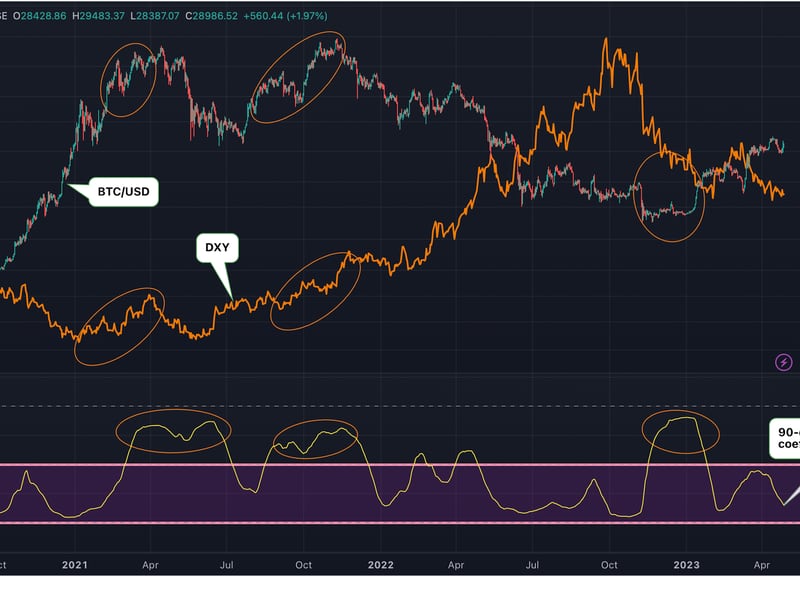Bitcoin's Negative Correlation With Dollar Index Strengthens Ahead of U.S. GDP Data

Bitcoin (BTC) has historically moved in the opposite direction to the dollar index (DXY), which gauges the greenback's exchange rate against major fiat currencies, including the euro.
The negative correlation has strengthened, reversing the brief let up witnessed in late March, and indicating scope for accelerated gains in the cryptocurrency in the case of a continued dollar slide following the release of the U.S. GDP data on Thursday.
The 90-day correlation coefficient between bitcoin and the dollar index has slipped to a two-month low of -0.70, according to data from charting platform TradingView. It had weakened to -0.11 four weeks ago.
Correlations are measured on a scale of -1 to +1. Values skewed towards -1 indicate that lower prices for one variable are associated with higher prices for the other.

Bitcoin and the DXY have been mostly negatively correlated over the past three years, except in times where crypto-specific factors overshadowed the dollar trends. For instance, bitcoin fell in late 2022 as the collapse of crypto exchange FTX kept investors from cheering weakness in the U.S. currency. A similar breakdown was seen in the lead up to Coinbase's Nasdaq debut in April 2021 and the launch of a futures-based exchange-traded fund in the U.S. the following October.
Focus on GDP
At 12:30 UTC, the U.S. Bureau of Economic Analysis will release its preliminary estimate of first-quarter gross domestic product (GDP). The data is likely to show the world's largest economy grew at an annualized rate of 2.0%, a slower pace than the 2.6% of fourth-quarter 2022, according to Reuters estimates published by FXStreet.
Several economic indicators and bond market metrics have been warning of an economic recession for months. The dollar index has declined by over 12% since early October in hopes that the Federal Reserve would halt interest rate hikes and resort to liquidity easing to support the economy.
Besides, traders are back to pricing three interest-rate cuts by year-end in the wake of issues at First Republic Bank, even though the Fed did not cut rates and maintained a hawkish or anti-stimulus bias following the much severe banking crisis episode of March.
With so much dovish expectations already in the air, the GDP figure might have to indicate a sharper-than-expected moderation in economic activity to trigger a deeper dollar sell-off and rally in risk assets, including cryptocurrencies.
It also means that a upbeat figure may see markets price out rate cuts and lift the dollar higher.
"The market eyes growth at 2% – shouldn't move markets too intently given the backward nature of the data point – would need to be a big beat/miss to the move rates expectations and the USD, gold, Nasdaq," Chris Weston, head of research at Pepperstone, said in a tweet.
At press time, bitcoin changed hands at $29,010, representing a 2% gain on the day. The dollar index was little changed at 101.50.








